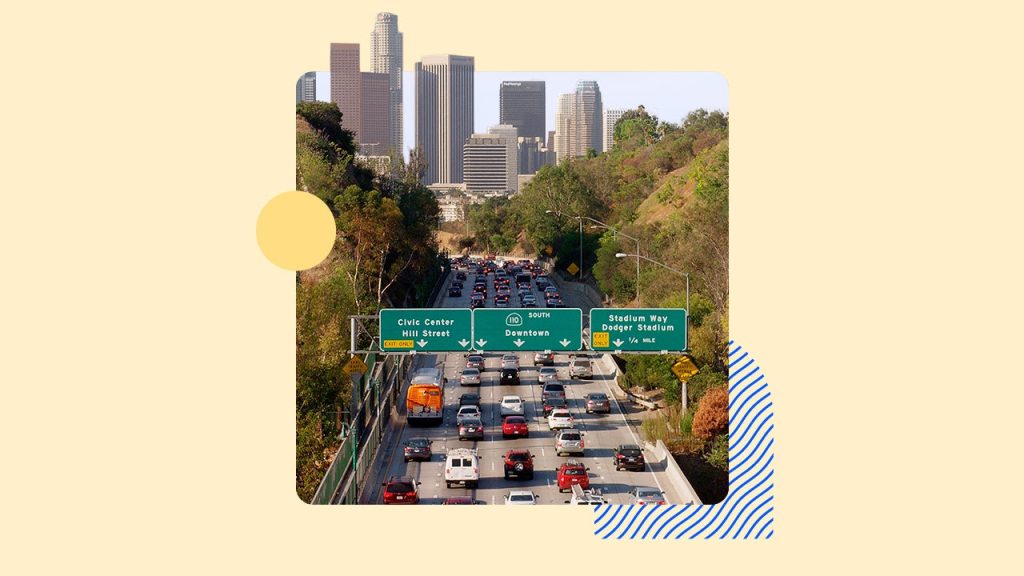Chris Sattlberger/GettyImages; Illustration by Hunter Newton/Bankrate
Key takeaways
- California drivers must at least meet the liability auto insurance coverage requirements of 15/30/5 to drive legally.
- You can be fined up to $500 out of pocket if you are convicted of driving without insurance in California, depending on whether it’s your first or subsequent offense.
- California is a “no pay, no play” state, which prevents an uninsured not-at-fault driver from suing an insured at-fault driver for non-economic damage, such as pain and suffering or inconvenience.
Can you drive a car without insurance in California? The answer is a resounding “no.” Driving without insurance in the Golden State leaves you liable for fines, license suspension and vehicle impoundment. The state takes insurance laws seriously, and if you are caught — especially if it is after an accident — the consequences can be severe. Bankrate reviewed California state law to help you understand what you are required to do to drive legally and the ramifications you are likely to face if you drive without insurance in California.
California car insurance laws
First, let’s take a second to understand what it means to be driving without insurance in California. In this state, you only meet the legally required amount of coverage when you have:
- $15,000 of bodily injury liability coverage per person
- $30,000 of bodily injury liability coverage per accident
- $5,000 of property damage liability coverage
Your policy might list these limits as “15/30/5.”
Ultimately, having this much liability coverage gives you something to fall back on. If you cause an accident or hit a person or object with your car, you can rely on your liability coverage to pay for damage up to the limits listed above. However, most insurance experts recommend carrying higher liability limits if you can afford to do so, as the damage from an at-fault incident could quickly surpass these minimum limits.
In California, driving without insurance means not carrying at least the above amounts of liability coverage. But that’s not all. Per the state vehicle code, you’re also required to show proof of that coverage to a law enforcement officer when requested to do so. You could show a paper copy of your insurance card or pull it up on your phone. Either way, to avoid a no-insurance ticket in California, you’ll need to show proof of insurance when asked.
There are alternatives to carrying an insurance policy. In California, you have a couple of other ways to prove financial responsibility. One way to prove you are able to be financially responsible for an accident is that you could deposit $35,000 cash with the California Department of Motor Vehicles (DMV) or get a $35,000 surety bond. However, in most cases, buying an insurance policy is the cheapest and easiest way to get the proof of financial responsibility that you need to legally drive in the state.
What happens if you are caught driving without insurance in California?
California is a state that takes driving without insurance very seriously. Penalties for driving without insurance in California can add up quickly, especially if California penalty assessments are added to your infraction. If you’re a repeat offender or get into an accident without coverage, you may face more severe consequences for driving without insurance. Understanding what happens if you don’t have car insurance in California can help you avoid these legal and financial penalties.
First conviction
Getting caught driving without insurance in California once typically results in a fine between $100 and $200. Penalty assessments may be added on top of this fine, which could bring the total closer to $400. A more severe risk is that the court could also decide to impound your vehicle, even if this is the first time you were caught driving without insurance.
Second and subsequent convictions
If you are caught driving uninsured in California more than once within a span of three years, the fine significantly increases to an amount between $200 and $500. Penalty assessments also increase to somewhere between $520 to $1,300, which can bring total fines to $1,020 and $1,800. Again, you also face the possibility of your vehicle getting impounded.
California penalty assessments
Driving without insurance in California can lead to substantial penalties on top of the initial fine. These assessments can multiply the original fine several times over. Here’s a breakdown of how these penalties can add up:
These assessments can quickly escalate the cost. For example, a $100 fine can rise to $390 when all penalties are included. The maximum $500 fine could total $1,950 with these assessments applied. This does not even account for additional costs if you cause damage while driving uninsured.
Local officials have discretion over which assessments to apply, so the total amount may vary based on your location. However, understanding these potential costs highlights the importance of maintaining the required insurance coverage in California to avoid severe financial consequences.
What happens if you cause an accident without insurance?
Causing an accident without insurance in California can be costly. If you caused the accident, you’re on the hook for paying the resulting damage. That means you’ll need to cover repairs to the other person’s vehicle and their medical expenses out of your own pocket. A 2019 report from the National Highway Traffic Safety Association found the average critically injured car accident survivor amassed nearly $980,000 in medical costs and lost wages. Even if you can’t pay the money right away, the other driver could sue you and have your wages garnished until they get the amount you owe in full.
On top of that, getting into an accident without insurance or the ability to provide evidence of financial responsibility puts you at risk of license suspension. Usually, you’ll be without your license for one year, at which point you can get your license reinstated if your insurance company files an SR-22 on your behalf. You’ll need to keep that SR-22 in place for three years. Average car insurance rates for high-risk drivers, such as those with SR-22 requirements, are typically much higher than rates for standard drivers.
Even if you weren’t the at-fault driver, driving without insurance in California limits your recourse after an accident. The other driver’s liability policy can pay for your car repairs and medical bills up to the policy limits, but because California is a “no pay, no play” state, you can’t try to get compensation for non-economic damage, such as pain and suffering.
Frequently asked questions
Read the full article here










